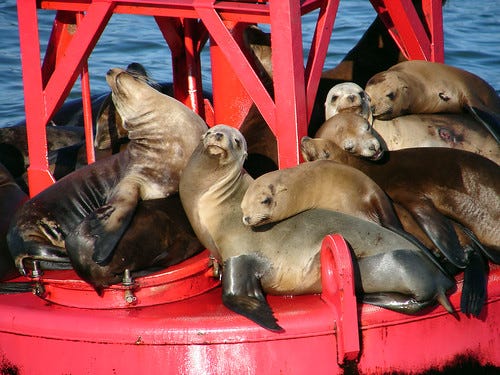(Listen to the radio version here.)
At the end of the first Star Wars movie, even as the good guys were celebrating their triumph, we viewers were left unsettled—when the Death Star exploded, we saw Darth Vader spinning off somewhere into that galaxy far, far away, and we knew that the bad guys would regroup.
During the heady first years following the opening of the newly empowered Environmental Protection Agency and the strengthening of the Clean Air Act in 1970, people trying to protect the environment enjoyed victory after victory after victory. The Federal Insecticide, Fungicide, and Rodenticide Act (FIFRA) was enacted in 1972, and at the same time, most uses of DDT were banned in the United States. The Clean Water Act was passed in 1972 and made even stronger in 1977. And the Endangered Species Act was passed in 1973. It was over, and the good guys won!
The moment the EPA got in gear in 1970, I felt both relieved and ready to focus on other important issues—civil rights (my father was a vicious racist, so I had a good idea of at least some of what Black people were up against), ending the war in Vietnam (the fall of Saigon, when we abandoned Vietnam, happened in April 1975), ending the draft (that would end in 1973), and women’s rights. (I could not even get my own credit card before 1974. Before I got married in 1972, my father would have had to be on the account, and after I got married, Russ would.) So many problems, but at least all the environmental issues had been solved!
Star Wars didn’t come out until 1977, but I should have been paying attention to the Darth Vaders on the environmental front. Some companies did their best to jump on the environmental bandwagon, or at least to give us the impression that they were as concerned as we were. McDonald’s produced a wonderful teachers’ packet about ecology that I used in my own classrooms, containing all kinds of solid information about important topics such as food chains, the hydrologic cycle, and recycling, with ditto masters and overhead projector transparencies that were as useful as they were informative.
McDonald’s met legal environmental standards even as those standards got stricter. (Of course, the government always gives corporations and industry a long lead time before laws and their enforcement kick in, even with regard to the most critically important regulations.) McDonald’s and other fast food franchises haven’t been positive or even neutral forces for the environment—beef production bears an extremely heavy environmental footprint, which is why #2 in my 101 Ways to Help Birds is “Eat lower on the food chain, and especially eat less beef.” I wrote that meat production involves:
habitat destruction and loss, pesticide use, heavy water demand, disease, manure runoff into lakes and streams, and hormones and antibiotics working their way into natural systems. It requires far more acres to produce the same number of calories of meat than of vegetables or grains. And intensive “factory farms,” where animals are overcrowded and stressed, can become hotbeds of disease and are a primary source of bird flu (which might more appropriately be called “overcrowded poultry flu”), salmonella, conjunctivitis, and other disease organisms. Meat production in particular causes a huge array of serious problems for birds.
I didn’t even mention the high amount of methane cows produce, or how much of their feed is genetically modified so the corn can withstand huge amounts of herbicide.

101 Ways to Help Birds wasn’t published till 2006. In the 70s, a lot of environmentalists, including me, didn’t appreciate how complex the interweaving of so many issues was. I felt sorry for the few big companies that, like McDonald’s, at least made an effort to please their greener customers.
Environmentalists pressured them relentlessly to stop using so much unrecyclable polystyrene packaging for their sandwiches. Finally, in 1990, with great fanfare, McDonald’s switched to cardboard, but it turns out that both paper and cardboard food wrappings are laced with per- and polyfluoroalkyl substances (PFAS), bioaccumulating chemicals that are as much “forever chemicals” as DDT. Ironically, we’ve been learning a lot about this right as McDonald’s has been bowing to public pressure to finally phase out their drinking straws, and guess what? Researchers are now discovering that just about all paper drinking straws and most bamboo straws are also laced with PFAS, which have, for many decades, also been added to a great many pesticides as “inert ingredients” without any flags from the EPA.
Most companies just barely, and only under legal pressure, follow new environmental laws. But some companies from the start not only ignored the new laws—they violated them with shocking impunity. The Montrose Chemical Corporation of California was the largest producer of DDT in the United States from 1947 until it stopped production in 1982. Obviously they generated a lot of contaminated waste, which they were supposed to dump in tightly sealed barrels at a deep sea site between the California coast and Santa Catalina Island. But between the late 1950s and early 1970s, the company discharged an estimated 1,700 tons of DDT directly into the ocean via Los Angeles County’s sewer system, contaminating sediment on the ocean floor off the southern California coast. In addition to all that, many of the hundreds of thousands of barrels of waste laced with DDT that were supposed to end up, tightly sealed, in deep water were not only dumped much closer to the coast, they were intentionally punctured to ensure that they would sink.
Bald Eagles on Santa Catalina Island were unable to reproduce at all for decades because the DDT caused their eggshells to become too thin.
Even today, in 2024, California sea lions have high levels of DDT in their tissues and a high rate of cancer, usually rare in wild animals.

When California sea lions die and ultimately wash to shore, critically endangered California Condors often serve as the cleanup crew. Tragically, those who feed along a long stretch of California coast still have elevated DDT levels in their blood more than a half-century after DDT was banned. In order to minimize how many sea lions they eat, managers try to lure the condors away from the coast by providing carcasses supplied by area farmers, but it’s impossible to keep the condors entirely away from their ancestral feeding areas. Most of the photos I’ve taken of condors in California are of individuals along this dangerously toxic stretch of coast.
In the 70s, overt violations of new environmental laws were sadly common—that same stretch of California coast is also laced with PCBs from other chemical companies that, along with the Montrose Chemical Corporation, have been fined a total of only about $140 million for cleanup, though many lawsuits are still ongoing. If you’ve managed to get this far into your life without becoming cynical and hope to stay that way, try to avoid learning about the impact chemical, pharmaceutical, agricultural, and energy corporations have had on your own health and the health of birds.
The Montrose Chemical Corporation and other egregious scofflaws were bad enough. But at the very time environmentalists were celebrating our victories in the 70s, a few insidious forces were already organizing to eviscerate the EPA and just about every environmental law in quieter, less overt but even more damaging and permanent ways. The Heritage Foundation came into being in 1973 and the Koch family started their political work that same decade, both with a laser focus on how to undermine the environmental laws protecting human beings and wildlife while staying under the radar as long as possible even as the damage snowballed. Now their work is reaching critical mass.









I didn't realize DDT was still effecting animals such as the sea lions...sad, sad, sad....